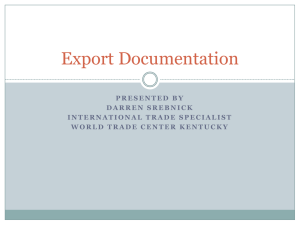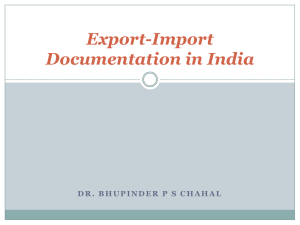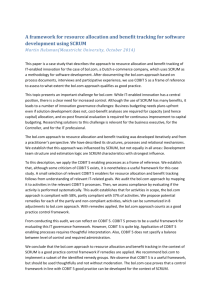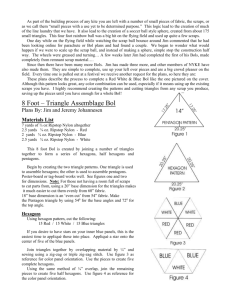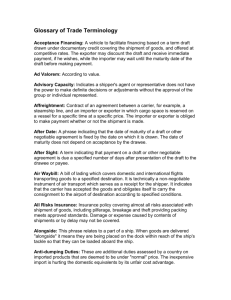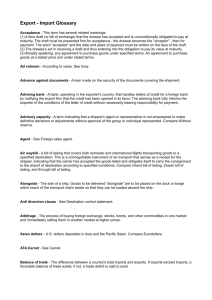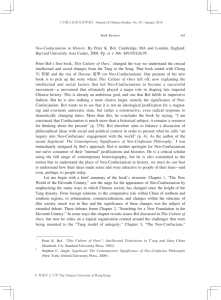File - Putra Selaparang
advertisement
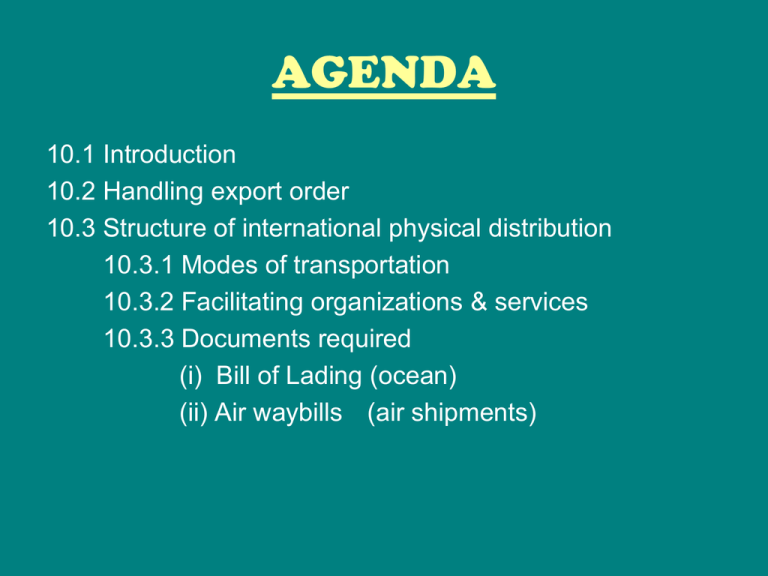
AGENDA 10.1 Introduction 10.2 Handling export order 10.3 Structure of international physical distribution 10.3.1 Modes of transportation 10.3.2 Facilitating organizations & services 10.3.3 Documents required (i) Bill of Lading (ocean) (ii) Air waybills (air shipments) 10.0 Introduction • The success or failure of the export business of a firm depends entirely upon securing orders from buyers, delivering products in s good condition at the correct time. • This depends upon the correct handling of export procedures. • All documents and procedures must be carefully followed in order to avoid violations of laws of the countries involved. 10.1 The Export Procedure Importer (Inquiry) Exporter (Response) Make general inquiry Sends catalogs & price list Requests pro forma invoice (price quotation) Sends pro forma invoice Sends Purchase Order (P.O) Receives P.O Directly from prospective importer Order Received From branch or representative overseas 10.3 Structure of International Physical Distribution • To facilitate the flow of products across countries there has evolve a complex structure of specialized marketing institutions, organizations and services. 10.3.1 Modes of Transportation Ocean Air Rail Truck Inland Water Pipeline 10.3.2 Facilitating Organizations & Services (a) (b) (c) (d) (e) Freight forwarders Warehousing Free areas Transportation insurance Export packing (a) Freight Forwarder Forwarding of an export shipment from the point of origin to the ultimate destination in some foreign market. (b) Warehousing A warehouse is a commercial building for storage of goods. (c) Free Area An enclosed, policed area without resident population in, adjacent to, or near a port of entry, into which foreign goods. Two types of free area: (i) free port (ii) free perimeter (d) Transportation Insurance To protect goods from lost and damage during physical movement from seller to buyer. (e) Export Packing To deliver the commodity in good condition to the foreign customer. 10.3.3 Documents Required (a) Export license (b) export declaration (c) Commercial invoice (d) Consular invoice/special custom invoice/ facture (e) Packing list (f) Certification and other documents (a) Export license Prepared by the exporter, given to the shipping company, then filled with customs officials at the port of exporter. (b) Export declaration Includes complete information about the shipment. . (c) Commercial Invoice The bill that the exporter(consignor) sends to the importer(consignee). To calculate tariff. (d) Consular invoice/ special custom service/ facture Obtained by the exporter of home country from the governmental representative of the importer’s country. (e) Packing List Usually attached to a commercial invoice. Provides additional details on goods being shipped overseas if it is not shown in the commercial invoice. (f) Certificate of Origin Certifying the place of origin of the merchandise. (i) Ocean Transportation & Bill of Lading Three purpose of ocean Bill of Lading (BOL): 1. A contract of carriage between shipper and transportation company. 2. Receipt of goods issued by steamship company. 3. Evidence of title to merchandise. Selecting the Route of an Ocean Shipment Two major factors: 1. The route that bring the shipment to its port of destinations in the shortest time. 2. The route which is more economical. Freight rates and space reservations • The shippers will sign a contract which has lower rates. • Usually sailing schedules to destination always unknown. Therefore, contract with foreign freight forwarder will make space reservation at no cost. Container shipment • Fill the dock before load in vessel. Dock receipt • If not noted any in dock receipt, means goods in good condition of container and vice versa. Types of Bill of Lading (BOL) Straight BOL Open BOL Shipped BOL Stale BOL Through BOL Groupage BOL Transhipment BOL Ocean BOL Claused BOL Electronic BOL Short Form Straight Bill of Lading Ocean Bill of Lading Open Bill of Lading Electronic Bill of Lading (ii) Air Shipments & Air Waybills • Air waybill is used for air transport and is documentary evidence of the conclusion of a contract for carriage. Air waybill It serves as: •Proof of receipt of the goods for shipment; •An invoice for the freight; •A certificate of insurance; •A guide to airline staff for the handling, dispatch and delivery of the consignment.


